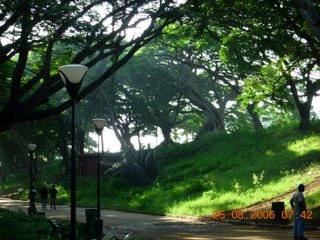The week begins with and sustains a sense of breathless activity. Friday seems like an encore to a full-throated opera performance, ending on a lingering falsetto. I rise from my seat trying to catch my breath and make an effort to collect fragments of the world outside which pierce through my consciousness. Though this might sound a bit like my livelihood revolves around musical performances; nothing could be farther from reality. This was a mere exploratory effort to juxtapose music with my corporate work life, which as noted above, takes an orchestrated break every Friday.
This Friday was different though. Exhaustion and exhilaration were within a hair’s breadth of each other. I was leaving for Goa right after work on Friday evening. Packing essentials and accessories for the trip was achieved in a time span of 15 minutes during which I was also providing, shall I say, educative inputs on a cross-border deal over a conference call from NY. All the breathlessness was to be well-rewarded with ocean breeze over the next couple of days!
8 of us were booked onto a sleeper bus for the 12-hour journey to Goa. In between all the chatter, we did manage to catch some judicious shut-eye, mindful of our plans to ignore the nightly sleep routine over the next couple of days. A lazily sunny Saturday morning welcomed us in Mapusa the next morning. It seemed like we’d entered a different world. This was not the first time that I was in Goa but each visit is a widely different experience. We checked into our suites at the Sterling Resort, which is well-located in North Goa, admired the expanse of the ocean confronting us, the accompanying roar of the waves and unpacked before descending to the restaurant for breakfast. There’s something about the balmy ocean breeze and the absence of city sounds which multiplies your appetite several times. The options provided in the menu were thoroughly exhausted by the group in a diligent, well-intentioned effort to ensure that fellow holidayers residing at Sterling could explore other restaurants in town for their morning staples.
Our appetites perfectly sated, we were raring to go.
The best way to explore Goa is on bikes. And to accept, in fact actively welcome the possibility of losing your way. That way, you can turn into any quaint narrow street or even dirt road that catches your fancy. With a rather rudimentary map of Goa to guide us and no specific destination in mind, we set off on 4 bikes. The collective thought was to explore the lesser frequented beaches in North Goa before heading out to the de riguer Baga, Calangute and Anjuna. So we set off on the northward breeze and soon found ourselves entwined in winding lanes leading into haystacks and lazy fields. This is when the charm of Goa permeates your senses imperceptibly. Brightly painted houses with sloping roofs and wooden eaves, the quaint taverns often imaginatively named, pristine white churches with blue windows, rows of palm trees lacing the white sandy beaches and the shimmering ocean beyond. The warm glow of sunshine reaches inside you.
We reached Morjim beach drunk on salty sea breeze and sunshine. The lazy serenity of the beach and its sunbathers seemed to me to be a strange combination of the human and the subliminal. The holidayers religiously submitting themselves to the sun seemed to create an unreal world where familiar constraints of time and space don’t intrude upon your senses. A hush seemed to have settled on what seemed to me as the Kingdom of the mid-afternoon sun and the garrulous ocean.
It doesn’t take us very long to shake off bags, watches (it strikes me as strange that watches even work in Goa!), cameras, cellphones and run into the inviting waves. We submit to being tossed around by the waves, taste the salt, try and manage a few strokes of freestyle swimming and play some ball. Duly baptized, we head back to shore. The shacks which dot the beaches are a superbly inviting respite from the sun and serve up most things that are apt to catch your fancy, which at the outset would most definitely include chilled beer. We all promptly order ample quantities of the elixir. Words cannot capture the serenity achieved from downing locally brewed King’s beer with the iridescent ocean in direct view. Some of us decide to carry bottles of beer with us for the ride to the next beach. We feel much more integrated into Goan atmosphere and less like tourists as we ride through the narrow streets, salt in our hair, taking gulps of beer by turns. Bare-chested men in dreadlocks, weather-worn khaki shorts, sun-tanned bodies with backpacks pass us by on bikes looking like they’ve spent their lives riding around the Goan countryside.
We sing, we yell as we pass each other on bikes, we stop and take pictures at churches.
Reaching Arambol beach is more complicated than I’d imagined. After taking a few light-hearted turns off the main street and not getting anywhere, we decide to stop and ask for directions. A narrow winding lane leads us towards the beach; shops lining both sides of the lane. Shops selling colorful scarves, bags, skirts, oddly shaped beads and jewelry of every hue imaginable, ‘hindu’ medicines and digestives. One of the shops even sports a billboard which invites people for guitar-making classes. My curiosity whetted by all the ‘oriental’ stuff on display, decidedly for the foreign tourists who flock to the Goan beaches, I make up my mind on exploring the shops on our way out from the beach.
The water shimmers in the sun, creating a silvery pathway all the way to the horizon. The surf hits the sand and makes music. We head for the shacks, order food by the truckload and wash it all down with feni, vodka and beer, while the ocean keeps us company. I find some cane lounge chairs on the beach, plonk myself into one of them, put my feet up and let the sun sink in to the rhythm of the waves. Time stands still.
On our way back, I stop at the quaint shops and buy myself a wraparound skirt, lingering awhile at the stone-and-bead jewelry. Shopping in Goa is a unique experience. For starters, the shop-owner and his assistant will have divergent views on the price of the same article in the shop. So once you point out the discrepancy, you have to wait patiently while they sort out their differences and present the consensual price to you. The next step is to carry out some good old-fashioned bargaining. The vibes from the shopkeepers suggest that they’d rather sell their wares to under-informed foreigners (and in some cases, hippies in a state of stupor) than thrifty Indians.
As we ride back on our way to Sterling, the sunset is almost upon us. A veil of calm, warm stillness seems to settle on the ocean breeze. I stop and take pictures of the setting sun as we pass over one of the bridges; a bright orange orb untrammeled by smog and dust. My mind feels perfectly at peace as we ride back. The breeze soothes my spirits and the glow of the sun still lingers.
But the calm serenity doesn’t last long. If anyone was harboring any thoughts about calling it a day after all that beach-hopping and riding around Goan countryside, they are quickly banished. The plan is to get changed and head towards the Saturday Night market. This weekly gala is a nocturnal pot pourri of dazzling colorful lights, loud karaoke music, tens of winding pathways lined with stalls selling almost everything, well under the stars and hundreds of people milling around. A prominently located stall specializes in tshirts of Mahatma Gandhi and Che Guevara. Everything is bathed in yellow and orange light and seems to move to the soft rhythm of the drums being played at a raised dais in a clearing. There are very few Indians in the crowd, which is mostly composed of sun-browned, freckled, white-toothed foreigners, looking very much at home in the middle of Goa. The crescendo of laughter and music seems to reach high into the sky. We head toward the row of food stalls. Russian, Lebanese, Ukranian, even German food stalls jostle each other for space. For the less adventurous tastebud, there’s pizza and walnut brownies. We spot a board exclaiming ‘Sangria’ and get ourselves a Styrofoam cup of the rather interesting beverage. Orange, yellow, and blue handmade paper and fabric lamps draw lingering glances from me, interrupted only by the mildly shocking price tags. A shiny new Royal Enfield Bullet occupies pride of place in the center of the clearing and has its crowd of admirers gazing at its red and chrome frame.
As I reluctantly leave the magic land of lights, music and laughter behind, I decide to make it a prime reason for my next visit to Goa. We head toward Fort Aguada for dinner at a beach shack. We discover the shack on a deserted stretch of the beach, with tempestuous waves charging the sand just a few feet away. The table is set with red checked covers, cane lounge chairs and thick chandles. We order wines and Chinese food.
Nirvana is not too far away.



